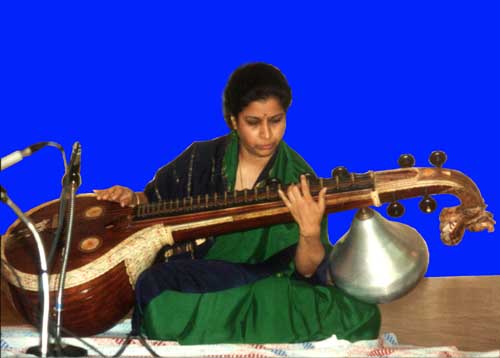The South Indian System of Music

Introduction
Carnatic sangeet, (Karnatik Sangit) is the south Indian system of music. It has a rich history and a very sophisticated theoretical system. The performers and composers have, gained a world class reputation by singing and playing instruments such as veena (vina), gottuvadyam, violin, and mridangam.
In the West, Carnatic Sangeet is not as well known as Hindustani Sangeet (north Indian music). Whenever Westerners think of Indian music, they immediately think of Ravi Shankar and the sitar. Although South Indian music is extremely sophisticated, there has not emerged an artist with the worldwide recognition that North Indians, like Ravi Shankar, have been able to generate.
Geographical Distribution
Carnatic Sangeet is found in the south Indian states of Tamil Nadu, Kerala, Andhra Pradesh and Carnatica. These states are known for their strong presentation of Dravidian culture.

History of Carnatic Sangeet
We can begin our discussion of the history of Carnatic Sangeet with Purandardas (1480-1564). He is considered to be the father of Carnatic Sangeet. He is given credit for the codification of the method of education, and is also credited with several thousand songs.
Venkat Mukhi Swami (17th century) is the grand theorist of Carnatic music. He was the one who developed the melakarta system. This is the system for classifying south Indian rags.
Carnatic music really acquired its present form in the 18th century. It was during this period that the “trinity” of Carnatic music, Thyagaraja, Shamashastri, and Muthuswami Dikshitar composed their famous compositions. In addition to our “trinity”. Numerous other musicians and composers enriched this tradition. Some notable personalities were; Papanasam Shivan, Gopala Krishna Bharati, Swati Tirunal, Mysore Vasudevachar, Narayan Tirtha, Uttukadu Venkatasubbair, Arunagiri Nathar, and Annamacharya.
Carnatic Music Theory
Carnatic music has a very highly developed theoretical system. It is based upon a complex system of ragam (rag) and thalam (tal). These describe the intricacies of the melodic and rhythmic forms respectively.
The melodic foundation is the ragam (rag). Ragam (rag) is basically the scale. The seven notes of the scale are Sa Ri Ga Ma Pa Dha and Ni. However, unlike a simple scale there are certain melodic restrictions and obligations. Each ragam (rag) has a particular way that it moves from note to note.
The ragams are categorised into various modes. These are referred to as mela, and there are 72 in number. The mela are conceptually similar to the thats of North Indian music. There is however, a major difference. South Indian scales allow chromatic forms that are not allowed in Hindustani sangeet. For instance it is perfectly acceptable for the first three notes (i.e., Sa Re Ga to all be roughly one semitone apart. It is these permissible forms which allow there to be so many mela.
The tal (thalam) is the rhythmic foundation to the system. The south Indian tals are defined by a system of clapping and waving, while this is much less important in the north. North Indian musicians define their tals by their theka.
Nomenclature is one of the biggest differences between North and South Indian music. It is normal for a particular rag or tal to be called one thing in the North and something totally different in the South. It is also common for the same name to be applied to very different rags and tals. It is theses differences in nomenclature that have made any theoretical reconciliation difficult.
Performance Styles and Vocal Tradition
Vocal music is the base for Carnatic Sangeet. This is reflected in the performance styles.
There are a number of sections to the Carnatic performance. Varanam is a form used to begin many south Indian performances. The word varanam literal means a description and this section is used to unfold the various important features of the ragam. The kritis are a fixed compositions in the rag. They have well identified composers and do not allow much scope for variation. However such compositions are often preceded by alapana. The alapana offers a way to unfold the ragam to the audience, and at the same time, allow the artist considerable scope for improvisation. The niruval and the kalpana swara also provide opportunities to improvise. Another common structure is the ragam, thanam, and, pallavi
South Indian performances are based upon three major sections. These are the pallavi anupallavi and charanam. These roughly correspond to the sthai, antara and the abhog in Hindustani sangeet.
Carnatic Instrumental Music
Carnatic music has a rich instrumental tradition. Instruments may be used as an accompaniment to vocal, or they may be performed solo. Although Carnatic instrumental is essentially an instrumental rendition of vocal music, both the technique and the pedagogy are highly formalised and very demanding.
Carnatic instrumentation falls into one of three categories, melodic, drone and percussion. Common drone instruments are the tanpura, and surpeti. Ottu may be used to provide drone for the accompaniment of nadaswaram. The most common melodic instruments are the veena (saraswati veena), violin, venu, and nadaswaram. Less common melodic instruments are the gottuvadyam and mukhaveena. The most common rhythm instruments are the mridangam, kanjira, murchang and ghatam. Tavil is generally used to accompany the nadaswaram.
Conclusion
The rich tradition of South Indian music is one of the worlds gems. The high performance standards and the well organised theoretical foundation put it on par with anything that world has seen, either East or West.
